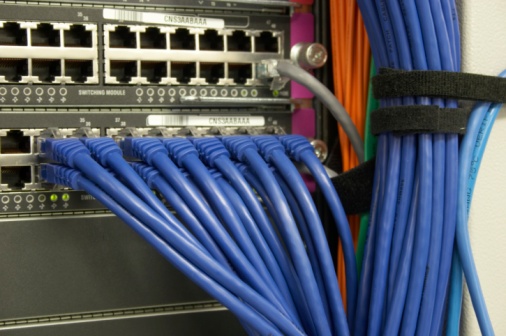10 Gigabit Ethernet Switches: From Dream to Reality
Wednesday, March 6, 2013Posted by Joel Thompson

By Laurent Masia, NETGEAR's senior product line manager, managed infrastructure.
As the number of connected devices is expected to grow exponentially in the coming years, it should come as no surprise that businesses are continuing to look for ways to alleviate network bottlenecks and deliver a fast and seamless response to unpredictable bandwidth demands.
In addition, the proliferation of data replication and the widespread adoption of server and storage virtualization in small and medium sized networks are driving the deployment of 10 Gigabit solutions for network connectivity.
There are various advantages to using 10 Gigabit Ethernet switching solutions, but for the purposes of this article, I’m going to focus on the three that are most beneficial for SMBs.
10 Gigabit Ethernet and The Server Edge: Better Efficiency
SMBs are optimizing their datacenters by consolidating servers to free up space, power, and management overhead. The first step in doing so usually involves consolidating applications onto fewer servers than the old single-application-per-server paradigm. Often, the next step is server virtualization.
As server virtualization relies heavily on networking and storage, virtual machines grow and require larger amounts of storage than one physical server can provide. Network Attached Storage (NAS) or Storage Area Networks (SANs) provide additional, dedicated storage for virtual machines but the connectivity between servers and storage must be fast to avoid bottlenecks. 10GbE provides the fastest interconnectivity for virtualized environments.
Copper vs. Fiber: Simpler and More Cost-Effective
There are three types of storage in a network: Direct-Attached Storage (DAS), Network Attached Storage (NAS) and Storage Area Networks (SAN). Each has its advantages, but SAN is emerging as the most flexible and scalable solution for data centers and high-density computing applications. However, the main drawback to SAN, has been the expense and specially trained staff necessary for installing and maintaining the Fibre Channel (FC) interconnect fabrics common in SAN environments. Regardless, SANs with Fibre Channel have become well established in large enterprises.
A new standard, the Internet Small Computer System Interface (iSCSI), is making 10 Gigabit Ethernet an attractive, alternative interconnect fabric for SAN applications. iSCSI is an extension of the SCSI protocol used for block transfers in most storage devices and Fibre Channel. The Internet extension defines protocols for extending block transfers over IP, allowing standard Ethernet infrastructure to be used as a SAN fabric. Basic iSCSI is supported in most operating systems today. The latest iSCSI capabilities allow 10 Gigabit Ethernet to compare very favorably to Fibre Channel as a SAN interconnect fabric:
• Reduced equipment and management costs: 10GbE networking components are less expensive than highly specialized Fibre Channel components and do not require a specialized skill set for installation and management
• Enhanced server management: iSCSI remote boot eliminates booting each server from its own direct-attached disk. Instead, servers can boot from an operating system image on the SAN. This is particularly advantageous for using diskless servers in rack-mount or blade server applications
• Improved disaster recovery: All information on a local SAN — including boot information, operating system images, applications, and data — can be duplicated on a remote SAN for quick and complete disaster recovery
• Excellent performance: Even transactional virtual machines, such as databases, can run over 10 Gigabit Ethernet and iSCSI SAN, without compromising performance
10 Gigabit Ethernet and the aggregation layer: reduce bottlenecks
Until recently, network design best practices recommended equipping the edge with Fast Ethernet (100Base-T), and using Gigabit uplinks to either the core (for two-tiered network architectures) or aggregation layer (for three-tiered networks). Today, traffic at the edge of the network has increased dramatically. Bandwidth-intensive applications have multiplied, and Gigabit Ethernet to the desktop has become more popular as its price has decreased. Broader adoption of Gigabit Ethernet to the desktop has increased the oversubscription ratios of the rest of the network and, as a result, a bottleneck between large amounts of Gigabit traffic at the edge of the network and the aggregation layer or core has been created.
10 Gigabit Ethernet allows the aggregation layer to scale to meet the increasing demands of users and applications. It can help bring oversubscription ratios back in line with network-design best practices, and provides some important advantages over aggregating multiple Gigabit Ethernet links:
• Less fiber usage: A 10 Gigabit Ethernet link uses fewer strands compared with Gigabit Ethernet aggregation, which uses one strand per Gigabit Ethernet link. Using 10 Gigabit Ethernet reduces cabling complexity and uses existing cabling efficiently
• Greater support for large streams: Traffic over aggregated 1 Gigabit Ethernet links can be limited to 1 Gbps streams because of packet sequencing requirements on end devices. 10 Gigabit Ethernet can more effectively support applications that generate multi Gigabit streams due to the greater capacity in a single 10 Gigabit Ethernet link
• Longer deployment lifetimes: 10 Gigabit Ethernet provides greater scalability than multiple Gigabit Ethernet links, resulting in a more future-proof network. Up to eight 10 Gigabit Ethernet links can be aggregated into a virtual 80-Gbps connection
Up until now, 10 Gigabit Ethernet switching has been an unattainable pipe dream for SMBs because of high cost, but NETGEAR’s 10 Gigabit switch solutions combine the latest advances in hardware and software engineering for higher availability, lower latency, power consumption and stronger security—all at industry-leading, breakthrough price points.
As copper prices continue to fall drastically, businesses are continuing to adopt it so they can embrace faster networking speeds to help manage the increased demands on their network caused by the proliferation of mobile devices and the influx of multimedia content.
